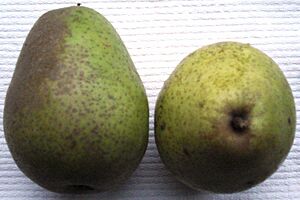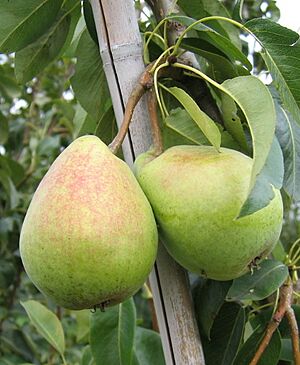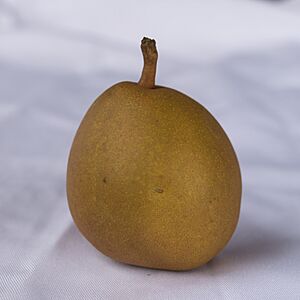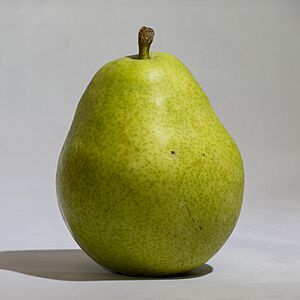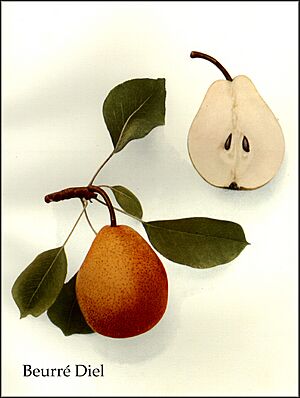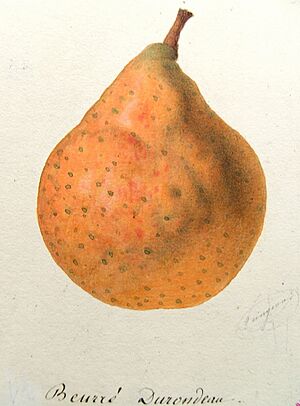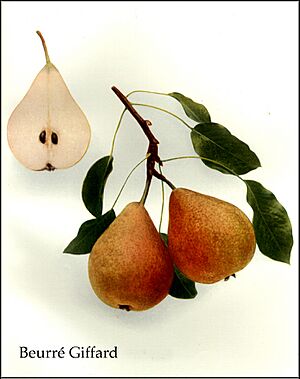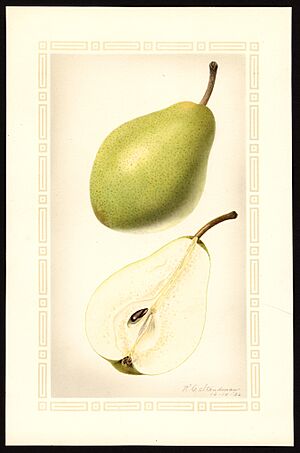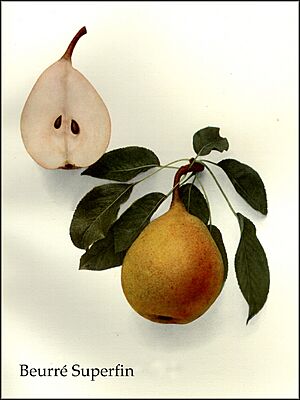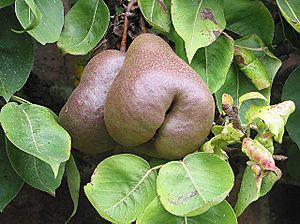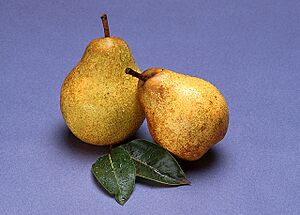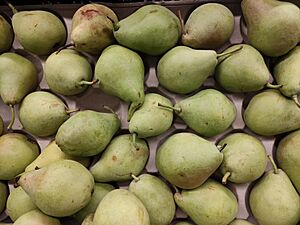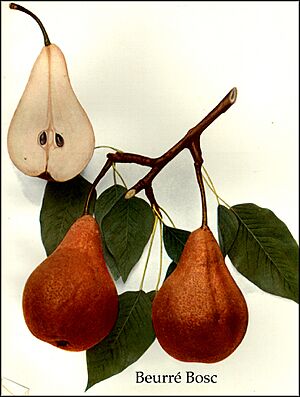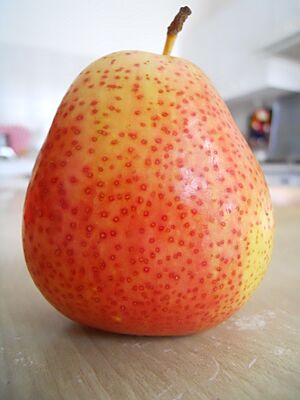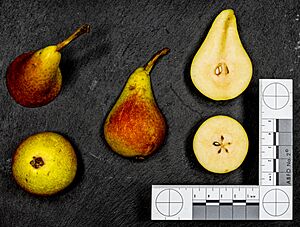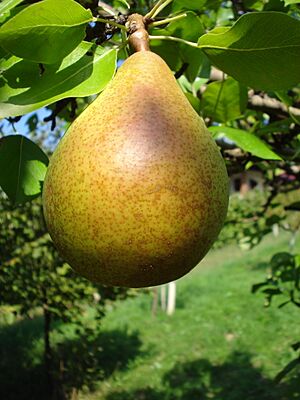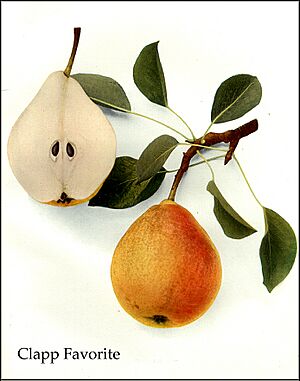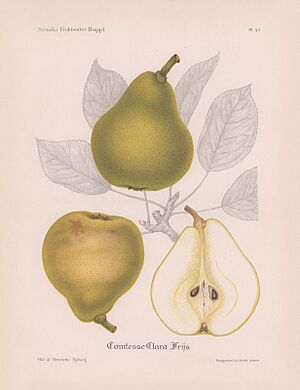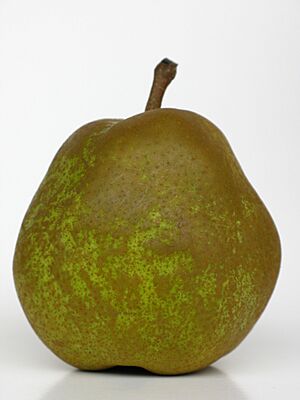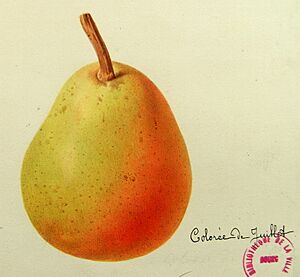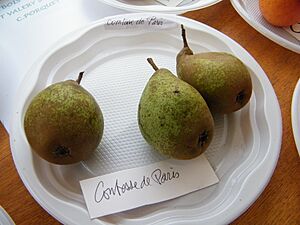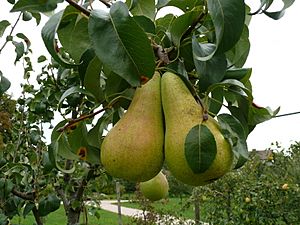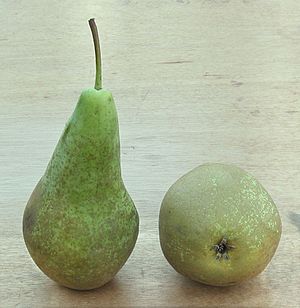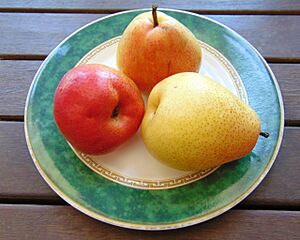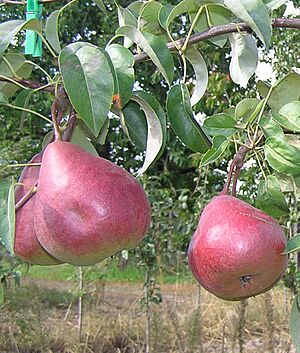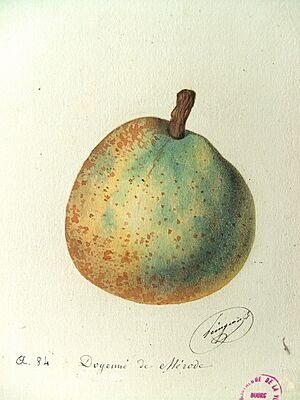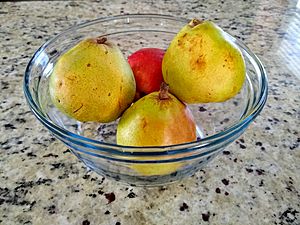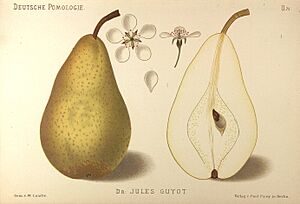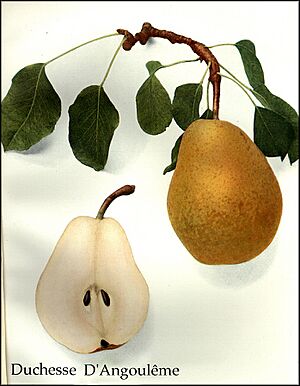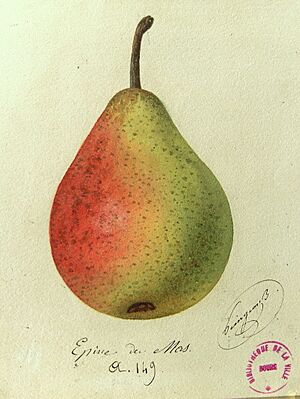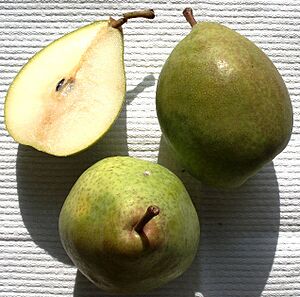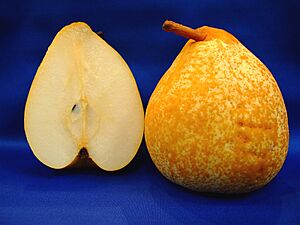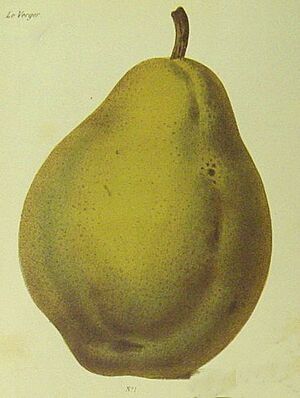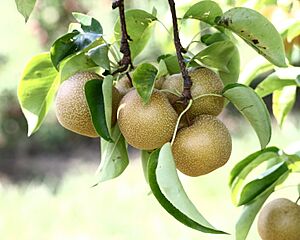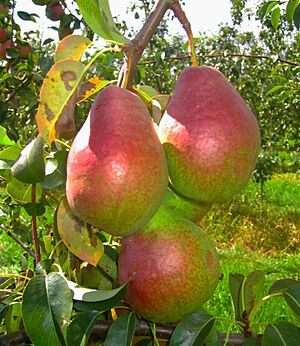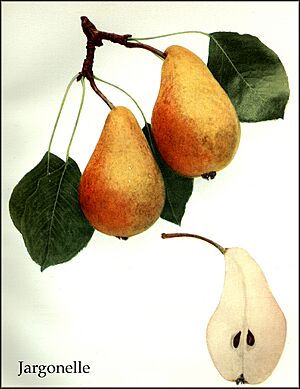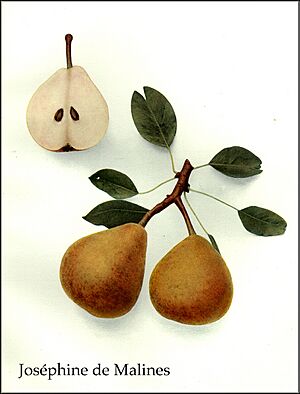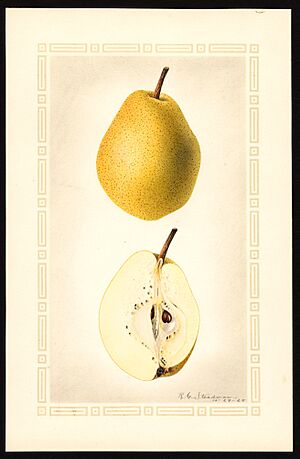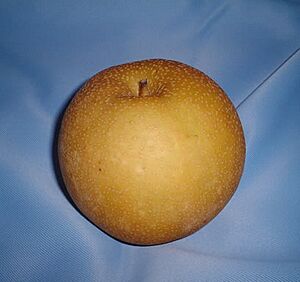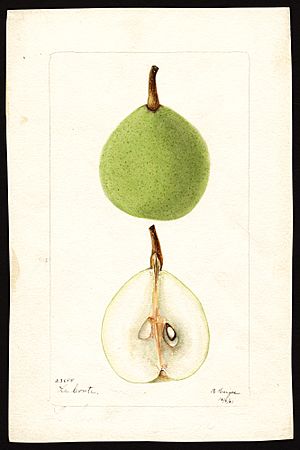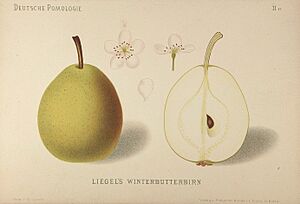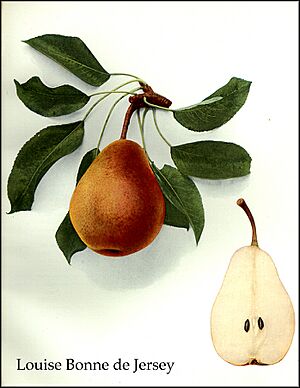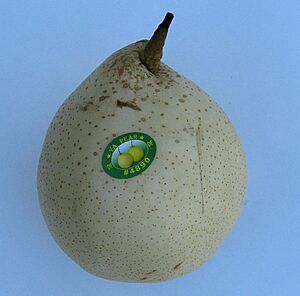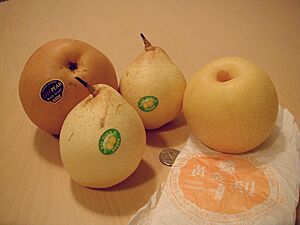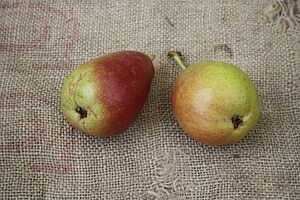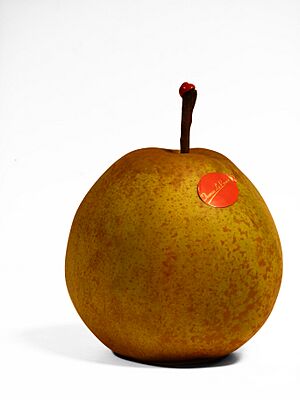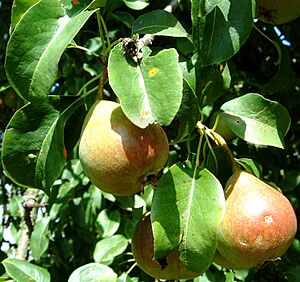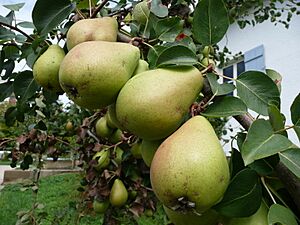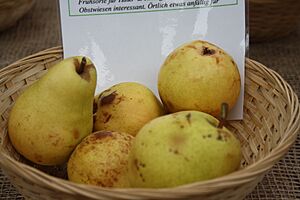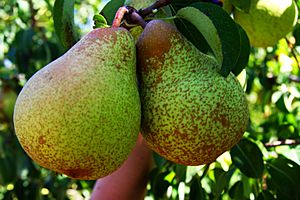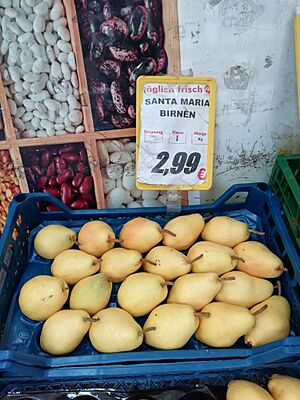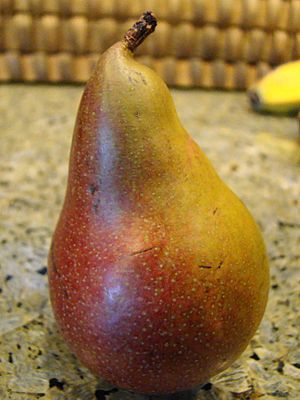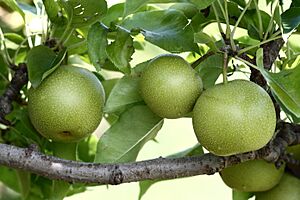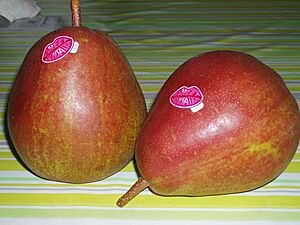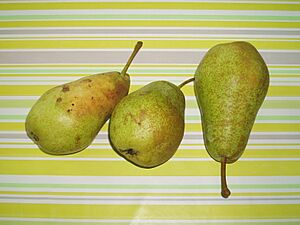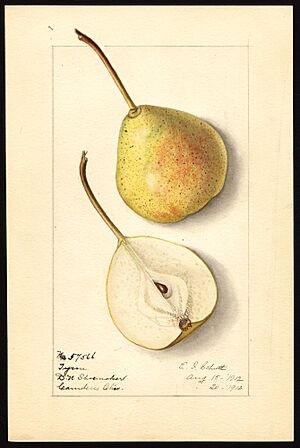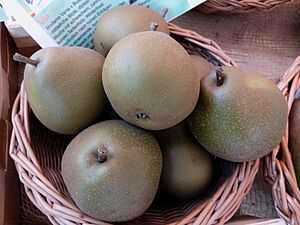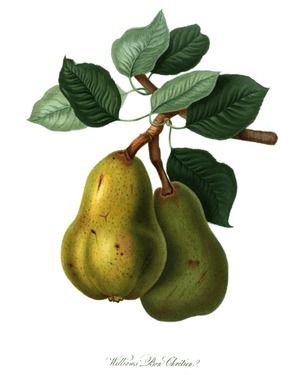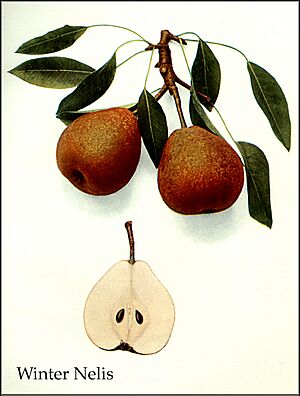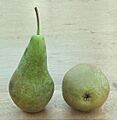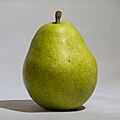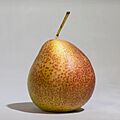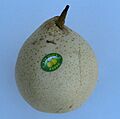List of pear cultivars facts for kids
Pears are delicious fruits, and there are over 3,000 different types, called cultivars! This article will tell you about some of the most common and important pear types. You'll learn where they came from, when they were first grown, and what they are best used for – like eating fresh, cooking, canning, drying, or making a special drink called perry. Some pears have even won special awards, like the "Award of Garden Merit" from the Royal Horticultural Society (marked with AGM) or the "First Class Certificate" (marked with FCC).
Popular Pear Types
| Common Name | Image | Origin | First Grown | Interesting Facts | Best Use | When to Pick (Days from Full Bloom) and Fireblight Resistance (F1 = very resistant, F5 = very susceptible) |
|---|---|---|---|---|---|---|
| Abate Fetel | France | 1869 | This pear is very popular in Italy. It can get a disease called scab. | Eating (stores for about 90 days) | 140–165 days (F3) | |
| Alexander Lucas | Loire et Cher, France | 1870 | This pear has three sets of chromosomes (triploid). | Eating (stores for about 120 days) | 157 days (F1) | |
| Alfa | (F1) | |||||
| Ambrosia | Indiana, US | 1978 | Pick these pears in mid-August. They are good at resisting fire blight disease. | Eating (stores for about 42 days) | ||
| Angelys | Angers, France | 1999 | This pear is a mix of 'Doyenné d'hiver' and 'Doyenné du Comice' pears. Pick them about 10 days after 'Doyenné du Comice'. | Eating (stores for about 180 days) | (F4) | |
| Anjou Red | This is a red version of the 'Anjou' pear. It doesn't grow as strongly as the regular 'Anjou'. | |||||
| Ayers | United States | This pear is a mix of two different pear types: P. communis and P. pyrifolia. | ||||
| Bambinella | Malta | |||||
| Bartlett Max Red | Europe | 1945 | This is a red version of the 'Bartlett' pear. It's a bit more resistant to fire blight than the regular 'Bartlett'. | |||
| Bartlett Red Sensation | Australia | 1940 | Another red version of the 'Bartlett' pear. The tree grows slower. | |||
| Beth | England | 1974 | This pear won the AGM award in 1993. It's a mix of 'Beurre Superfin' and 'Williams Bon Chretien'. | |||
| Beurre d' Anjou | France | Before 1628 | Eating (stores for about 150 days) | 140–165 days (F2) | ||
| Beurré Bedford | Bedford, England | 1902 (introduced 1921) | This pear is a mix of 'Marie Louise' and 'Durondeau'. | Eating in October and November | ||
| Bell | West Virginia, US | 1983 | This pear is resistant to fire blight disease. | Eating | ||
| Beurré Diel | Belgium | Before 1830 | Eating (stores for about 120 days) | |||
| Beurré Durandeau | Before 1823 | Pick these pears in late September or early October. | Eating, Canning (stores for about 150 days) | |||
| Beurré Giffard | Angers, France | 1825 | This pear doesn't store well for long. | Eating | 100–120 days | |
| Beurré Hardy | Boulogne-sur-Mer, France | Around 1820 (introduced around 1840) | Won the AGM award in 1993. It tends to produce a lot of fruit one year and less the next. | Eating (stores for about 90 days) | 130–150 days (F2) | |
| Beurré Superfin | Angers, France | 1837 | Won the AGM award in 2006. It ripens in late September. | Eating | ||
| Black Worcester | England | This pear is great for cooking and stores well. | Cooking | |||
| Blake's Pride | United States | 1965 (introduced 1998) | This pear came from a cross between two other pear types, US 446 and US 505. | |||
| Blanquilla | Spain | Eating | 100–130 days (F1) | |||
| Bon Rouge | This pear is a natural change (mutation) from the green 'William’s Bon Chretien' pear. | |||||
| Bosc | Belgium | Before 1807 | Great for eating, baking, cooking, and especially for poaching (cooking in liquid). | Eating, Baking (stores for about 120 days) | 150–165 days (F1) | |
| Bristol Cross | Bristol, England | 1920 | This pear is a mix of 'Williams' and 'Conference' pears. | Eating | 142 days | |
| Butirra Precoce Morettini | Florence, Italy | 1956 | This pear is a mix of 'Coscia' and 'Williams' (Bartlett). It grows strongly and ripens 20 days before 'Bartlett'. It's one of the best early pears. | Eating | 100–125 days | |
| Carmen | Italy | 1980 (introduced 2000) | Pick these pears 18 days before 'Bartlett'. | Eating | ||
| Cascade | Oregon, US | 1975 | This pear has red skin. It's a mix of 'Bartlett Max Red' and 'Doyenné du Comice'. | Eating | ||
| Catillac | France | Before 1665 | This pear resists scab disease, making it good for organic gardens. | Cooking | ||
| Celina | Sweden & Norway | 1985 (selected 1997) | Pick these pears 17 days before 'Conference'. It's a mix of 'Colorée de Juillet' and 'Bartlett'. | Eating | ||
| Chojuro | Japan | 1895 | Eating | 140–155 days | ||
| Churchland | ||||||
| Clairgeau | Nantes, France | Around 1830 (introduced 1851) | The tree is healthy and produces a lot of fruit. It has excellent taste for dessert. | Eating, Cooking (stores for about 60 days) | ||
| Clapp's Favourite | Dorchester, Massachusetts, US | Around 1860 (introduced 1867) | It can easily get scab disease and is very likely to get fireblight. | Eating (stores for about 60 days) | 105–130 days | |
| Clara Frijs | Skensved, Denmark | Before 1858 | This is a very important pear type in Denmark. | Eating | ||
| Claude Blanchet | Vienne, Isère, France | 1877 | This pear grew from a random seed. | |||
| Colorée de Juillet | Rouen, France | 1857 (introduced 1867) | Eating | 90 days | ||
| Comtesse de Paris | Eure-et-Loire, France | 1884? or 1893? | Pick these pears in late October. They are good to eat from December to February. | Eating (stores for about 180 days) | 165 days | |
| Concorde | England | 1984 | Won the AGM award in 1993. It can easily get fireblight disease. It's a mix of 'Doyenné du Comice' and 'Conference'. | |||
| Condo | Wageningen, Netherlands | 1965 | This pear is a mix of 'Conference' and 'Doyenné du Comice'. | (stores for about 120 days) | ||
| Conference | Sawbridgeworth, Hertfordshire, England | 1884 (introduced 1894) | Won the FCC award in 1885 and the AGM award in 1993. It can easily get fireblight and canker diseases. | Eating (stores for about 120 days) | 160–180 days (F1) | |
| Corella | Australia | Late 19th century | This pear was brought to Australia by German settlers in the Barossa Valley. | |||
| Coscia | Italy | Before 1800 | This pear ripens very early. | Eating | 90–120 days (F1) | |
| Delfrap | France | 1955 | These pears tend to fall off the tree before they are ready to pick. | Eating | ||
| Dessertnaja | ||||||
| Dicolor | Pick these pears in late September. | Eating | (F4) | |||
| Don Guindo | Spain | It has a strong yellow color and a flavorful taste. | ||||
| Doppelte Philipp | Belgium | Around 1800 (introduced 1819) | Pick these pears in September. They are good to eat in November. | |||
| Doyenné du Comice | Angers, France | Before 1849 | Won the FCC award in 1900 and the AGM award in 1993. It tends to produce a lot of fruit one year and less the next. Pears might fall off the tree before picking. The tree grows strongly but doesn't always produce a lot of fruit. | Eating (stores for about 90 days) | 150–170 days (F5) | |
| Dr. Jules Guyot | Troyes, France | Around 1870 (introduced 1875) | This pear resists scab disease, good for organic gardening. It doesn't store well. | Eating (stores for about 25 days) | 105–125 days (F2) | |
| Duchess | England? France? | Late 18th century | Pick these pears in early October. | Eating, Canning | ||
| Duchesse d'Angouleme | France | 1809 (introduced 1815) | This tree is large and produces fruit regularly. It has good resistance to fire blight. | Eating | 150–170 days | |
| Earlibrite | ||||||
| Easter Beurré | Belgium | Around 1823 | Good to eat from December to March. | Eating | 160–185 days | |
| Eden | Israel | |||||
| Eldorado | California, US | 1945 | This pear has very good to excellent quality. It can be stored for a long time. | Eating, Canning | 140–160 days (F1) | |
| Elektra | (F5) | |||||
| Epine du Mas | Rochechouart, France | Before 1847 | Eating (stores for about 100 days) | |||
| Flamingo | South Africa | 1993 | This pear is a mix of 'Bon Rouge' and 'Forelle'. Its flesh is creamy white and soft. | Eating | ||
| Flemish Beauty | Flanders, Belgium | 1810 | This pear is very tough and can survive very cold temperatures (down to -45 degrees F). | Eating, Drying | 160–180 days | |
| Fondante d'Automne | France | Around 1825 | This is an old pear type from Flanders, grown by Fievee at Maubeuge. | |||
| Fondante de Charneux | Charneux, Belgium | Around 1800 | It can easily get fireblight disease. | Eating (stores for about 100 days) | 144 days | |
| Forelle | Eating | 160–190 days | ||||
| Gem | West Virginia, US | 1970 (introduced 2014) | Pick these pears in early September in West Virginia and Oregon. | Eating | ||
| General Leclerc | Angers, France | 1950 (introduced 1974) | This pear is a mix of 'Doyenne du Comice'. | Eating (stores for about 150 days) | ||
| Gerburg | ||||||
| Glou Morceau | Belgium | 1750 | Good to eat from November to December. | Eating (stores for about 120 days) | 170–200 days | |
| Gourmet | South Dakota, US | 1954 (selected 1969) | These pears are 56–74 mm wide. The flesh is firm, yellow, crisp, and juicy. The pollen is sterile. Pick in the third week of September in South Dakota. | Eating | ||
| Golden Spice | This pear has small fruit and is very tough. | |||||
| Gorham | New York, US | 1923 | This pear is a mix of 'Bartlett' and 'Josephine de Malines'. Won the AGM award in 2006. It ripens 14 days later than 'Bartlett'. | |||
| Grand Champion | Oregon, US | 1936 | This pear is a natural change (mutation) from 'Gorham'. | |||
| Grüne Jagdbirne | Germany ? | Before 1936 | Pick these pears in late October. | Perry | ||
| Harobig | ||||||
| Harovin Sundown | ||||||
| Harrow Crisp | ||||||
| Harrow Delight | Ontario, Canada | 1982 | This pear is tough and can grow in cold areas (zone 5). | |||
| Harrow Gold | ||||||
| Harrow Red | ||||||
| Harrow Sweet | Ontario, Canada | 1965 | (F1) | |||
| Harvest Queen | Ontario, Canada | 1982 | This pear is a mix of 'Williams' and other 'Williams' types. | Eating, Canning | ||
| Hermann | ||||||
| Herzogin Elsa | Germany | 1879 or 1885 | Pick these pears in late September. | Eating | ||
| Hessle | Yorkshire, England | Before 1827 | This pear resists diseases, making it good for organic gardening. | Eating | ||
| Highland | US | 1944 | This pear is a mix of 'Williams' and 'Doyenné du Comise'. | Eating | ||
| Honeysweet | US | 1955 (selected 1969) | These pears are 55–61 mm wide and 61–67 mm tall. They are a mix of 'Seckel' and other pears. Pick in early September. The flesh is buttery, sweet, and rich. | Eating | ||
| Hortensia | Dresden-Pillnitz, Germany | 1996 | This pear is a mix of 'Nordhäuser Winterforelle' and 'Clapp Favorite'. Pick in mid to late September. | Eating | ||
| Hosui (豊水) | National Institute of Fruit Tree Science, Japan | Around 1972 | These are often called 'Russet pears' or 'Russet apple pears'. | Cider, Cooking, Eating | 135–145 days | |
| Huntington | ||||||
| Ingeborg | Balsgård, Fjälkestad, Sweden | 1994 | This pear is a mix of 'Conference' and 'Bonne Louise'. It has three sets of chromosomes (triploid). It's the main pear type grown in Norway. | Eating | ||
| Isolda | It can easily get fireblight disease. | Eating | (F2) | |||
| Jargonell | France | Before 1690 | The tree is tough, healthy, and grows strongly. | Eating | ||
| Jeanne d'Arc | Rouen, France | 1893 | This pear is a mix of 'Diels Butterbirne' and 'Doyenne du Comice'. | Eating | ||
| Joséphine de Malines | Mechelen, Belgium | 1830 | Won the FCC award in 1901 and the AGM award in 1993. It was created by Esperen, a fruit expert and mayor in the 1800s. It's one of the best pears for late in the season. Pick in late October. Good to eat from January to March. | Eating (stores for about 120 days) | ||
| Kieffer | United States | This pear is a mix of the Chinese "sand pear" (P. pyrifolia) and probably 'Bartlett'. It's tough and can grow in many different climates (Zones 4–9). | Eating, Canning, Baking | 170–190 days | ||
| Kikusui | This is a Pyrus pyrifolia pear. It's not good for shipping long distances. | Eating | ||||
| Kosui (幸水) | National Institute of Fruit Tree Science, Japan | Around 1959 | This is the most important pear type in Japan. It's also called 'Russet apple pear'. | Cider, Cooking, Eating | 120–130 days | |
| La France | Vienne, Isere, France | 1864 | ||||
| Lategale | ||||||
| Laxton's Superb | England | 1901 (introduced 1913, in US 1937) | This pear is a mix of 'Beurré Superfin' and 'Bartlett'. It's not grown much anymore because it gets fireblight disease very easily. | |||
| Le Conte | This pear is a mix of Pyrus communis and P. pyrifolia. The tree grows strongly. | |||||
| Liegel | Malines, Belgium | 1788 | ||||
| Louise Bonne | Normandy, France | 1778 | It can easily get scab disease. | Eating (stores for about 120 days) | 141 days | |
| Luscious | South Dakota, US | 1967 | This pear is small to medium-sized, similar to 'Bartlett'. It's tough and can grow in cold areas (zone 4). | Eating | ||
| Magness | Maryland, US | 1960 | This pear is tough and can grow in warmer areas (Zone 6–9). It resists fire blight disease. | |||
| Maxine | Ohio, US | 1923 | This pear is tough and can grow in many different climates (zones 4–8). | |||
| Merton Pride | England | 1941 | ||||
| Moonglow | 1960 | This pear is a mix of 'Doyenne du Comice'. It's tough and can grow in many different climates (zones 5–8). | Eating, Canning | |||
| Moorcroft | Colwall, England | Before 1884 | Pick these pears in mid to late September. | Perry | ||
| Chinese White Pear | Also known as 'Nashi'. | |||||
| Nashi | Also known as Asian, Japanese, Chinese, Korean, Taiwanese, or sand pear. This is a Pyrus pyrifolia type. | |||||
| Nijisseiki (二十世紀) | Matsudo, Chiba, Japan | Around 1888 | Its name means "20th century." It's a green apple pear. | Cider, Cooking, Eating | 140–155 days | |
| Nordhäuser Winterforelle | Nordhausen, Germany | 1864 | Pick these pears in mid-October. Good to eat from January to March. | Eating (stores for about 120 days) | ||
| Oberösterreichische Weinbirne | Austria | Old | Pick these pears in mid-October. | Perry | ||
| Oldfield | Herefordshire, England | Early 1700s | Pick these pears in mid to late October. Process them 3–6 weeks after picking. | Perry | ||
| Onward | National Fruit Trials in Wisley, Surrey | 1947 | This pear is a mix of 'Laxton's Superb' and 'Doyenne du Comice'. | Eating | ||
| Orcas | Washington, US | 1966 | Can be stored in cold storage for 11 weeks. | 112–132 days | ||
| Orient | United States | This pear is a mix of P. communis and P. pyrifolia. It's tough and can grow in warmer areas (zones 5–8). | Canning | |||
| Packham | Australia | 1896 | This pear is a mix of 'Uvedale's St. Germain' and 'Williams'. | Eating (stores for about 90 days) | 150–165 days (F4) | |
| Paragon | Oregon, US | 1940s | The flesh is fine and has a wonderful flavor. The tree grows strongly. | Eating | ||
| Parker | Minnesota, US | This pear has large fruit, similar to 'Bartlett'. | ||||
| Parsonage | New Rochelle, New York | Around 1857 | ||||
| Passe Crassane | Rouen, France | 1855 | This pear was created by M. Boisbunel, a plant grower from Rouen, France. | Eating (stores for about 150 days) | 180–210 days (F4) | |
| Patten | Minnesota, US | This pear is tough and can survive very cold temperatures (down to -50 degrees F). It has large, soft, and juicy fruit. | Eating, Canning | |||
| Petersbirne | Germany | Before 1799 | Cooking, Juice, Drying (stores for about 30 days) | |||
| Piérre Corneille | France | Before 1895 | This pear tends to produce a lot of fruit one year and less the next. | Eating | ||
| Pineapple | United States | This pear is a mix of P. communis and P. pyrifolia. It's tough and can grow in warmer areas (zone 8–9). | Eating, Canning | |||
| Pitmaston | Worcester, England | 1841 | Won the FCC award in 1874. | Eating, Canning | ||
| Poire de Curé | Indre, France | 1760 | This pear has three sets of chromosomes (triploid). Pick in October. Good to eat from December to January. | Eating, Cooking (stores for about 130 days) | ||
| Potomac | US | 1961 | This pear is a mix of 'Moonglow' and 'Beurrè d'Anjou'. It's about 65 mm wide. Pick 2 weeks after 'Bartlett'. The flesh is buttery, similar to 'Beurré d'Anjou'. | Eating | ||
| President Drouard | Angers, France | 1870 | Pick in mid-October. Good to eat from November to January. | Eating | ||
| Prècoce de Trévoux | France | 1862 | It can easily get scab disease. | Eating (stores for about 50 days) | 105 days | |
| Rescue | Vancouver, B.C. | Before 1976 | These pears are 75–85 mm wide. Pick 6 days before 'Bartlett'. The flesh is cream-colored, soft, juicy, and similar to 'Clapp's Favorite'. | Eating (stores for about 12 weeks) | ||
| Rocha | Portugal | Eating (stores for about 210 days) | ||||
| Robert de Neufville | Geisenheim, Germany | 1896 | This pear is a mix of 'Auguste Jurie' and 'Clapp's Favourite'. Pick in late August. Its flavor is similar to 'Doyenné du Comice'. | Eating | ||
| Rosemarie | South Africa | 1974 | This pear is a mix of 'Bon Rouge' and 'Forelle'. | |||
| Santa Maria | Italy | 1951 | This pear is a mix of 'Williams' and 'Coscia'. | Eating | ||
| Schweizer Wasserbirne | Switzerland ? | Old | This pear has three sets of chromosomes (triploid). It yields a lot of juice (75–80%). | Juice, Drying | ||
| Seckel | United States, Philadelphia area | Late 17th century | It has some resistance to fireblight. It's tough and can grow in many different climates (zone 5–8). | Eating | 120–140 days | |
| Shenandoah | Kearneysville, West Virginia, US | 1985 (introduced 2003) | This pear ripens at a similar time to 'Beurre d'Anjou'. | Eating | ||
| Shinseki | It's tough and can grow in warmer areas (zone 6–9). | Eating | 125–135 days | |||
| Starkrimson | Michigan | 1939 (introduced 1956) | This pear is a red version of 'Clapp's Favourite'. It has thick, smooth, bright red skin and creamy, sweet, and fragrant flesh. | |||
| Siberian | This pear is extremely tough but its fruit is not good to eat. It's used to help other pear trees produce fruit (as a pollinator). | |||||
| Summer Beauty | ||||||
| Summercrisp | Minnesota, US | 1987 | Can be stored in cold storage for 6 weeks. It has a crisp texture like Asian Pears and is a medium-sized, mildly sweet fruit. | |||
| Sweet Sensation | Netherlands | 1992 (introduced 2010) | This pear is a natural change (mutation) of 'Doyenne du Comice'. | Eating | ||
| Taylor's gold | New Zealand | This is a russeted (brownish, rough skin) version of the 'Comice' pear. | ||||
| Tosca | ||||||
| Triomphe de Vienne | Isère, France | 1874 | This pear tends to produce a lot of fruit one year and less the next. | Eating | 156 days | |
| Tsu Li | This is a Pyrus pyrifolia pear. | Eating | 150–165 days | |||
| Turandot | Italy | 1980 (introduced 2000) | This pear is a mix of 'Dr. Guyot' and 'Bella di Giugno'. It can easily get fireblight disease. | Eating | ||
| Tyson | Philadelphia, US | 1794 | The tree is tough and resists fireblight. It's tough and can grow in many different climates (zone 5–8). Pick in early August. | Eating | ||
| Ure | Morden, Manitoba | This pear has juicy, small to medium-sized fruit. | ||||
| Uta | Dresden-Pillnitz, Germany | 1993 | This pear is a mix of 'Madame Verte' and 'Beurré Bosc'. Pick in mid-October. | Eating (stores for about 135 days) | ||
| Verdi | Wageningen, Netherlands | 1966 | ||||
| Virgouleuse | ||||||
| Williams | Berkshire, England | 1770 | This pear can easily get scab and fireblight diseases. Many are yellow. There are three main red versions: 'Max Red Bartlett', 'Sensation Red Bartlett', and 'Rosired Bartlett'. It's good for eating, baking, and cooking. You can even use it in recipes that call for apples! | Eating, Canning (stores for about 60 days) | 115–135 days (F3) | |
| Winter Nelis | Malines, Belgium | Before 1818 | Won the FCC award in 1902. It resists fireblight disease. | Eating (stores for about 120 days) | 160–185 days | |
| Xenia | Netherlands | 1968 (selected 2001, introduced 2008) | This pear is a mix of 'Triomphe de Vienne' and 'Nicolai Krier'. Pick 2 weeks after 'Conference'. | Eating (stores for about 90 days) | ||
| Ya Li | This is a Pyrus pyrifolia pear. | Eating | 150–165 days | |||
| Yakumo | This is a Pyrus pyrifolia pear. | Eating |
Perry Pears
Perry pears are special types of pears that are often too sour or bitter to eat fresh. Instead, they are used to make perry, which is like the pear version of apple cider (an alcoholic drink). Some pears, especially older ones from the U.S. and Canada, can be used for both perry and for eating.
Images for kids
See also
 In Spanish: Anexo:Cultivares de Pera para niños
In Spanish: Anexo:Cultivares de Pera para niños



